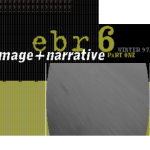
Returning to past formats in the electronic book review such as 'designwriting from the mid-1990s,' ebr co-editor Lai-Tze Fan alerts readers to a feature that is as much a part of our journal's publication, and positioning, as the essays themselves. As annotations in the margins of print texts allow readers to reference earlier texts, a more interactive, intertextual and perhaps more accessible conversation is made available within and among digital texts.
At a moment when scholarship can be shared before publication (through preprints on ArXiv and MediArXiv), archived digitally, and often circulated through corporate services like Academia.edu and ResearchGate, there has been a tendency of these existing dissemination methods toward presenting one essay at a time, often without the context of the site-specific platforms and collective publications and conversations where a given essay may have originally been published. As a contrast to the decontextualized and ahistorical approach to presenting essays, ebr is now in the process of gathering together essays whose authors (or readers) have self-consciously linked their own essays with others in the ebr archive, encouraging what can be described as an ebr intertext.
Like most scholarly journals, ebr regularly updates its archive across different versions (we are currently in version 7.0), so that past essays are accessible in current formats. In this way, designwritings from the mid-1990s are recast in the current format. But here, too, we risk losing the intertext that is as much a part of our publication as the essays themselves. Over the past three decades (and seven versions) the changing formats and page designs have been accompanied by less noticeable updates, with one essay and one or a few editors at a time. The editorial glosses that appear marginally in new essays are drafted by editors and guest scholars, whose involvement with the journal may not only involve soliciting new works but also systematically looking back over threads that are of interest to their own, current scholarship. In this way, as both our editorial collective and our archive are updated, we keep track of the historical intertext that the journal has been generating over the years.
Indeed, maintaining and advancing this intertext is one of the key tasks assigned to incoming editors, whose own prior reading gets conveyed through the marginal glosses they add to many, if not all of the new essays and reviews that we commission. This way, the ‘links’ that define digital publication are made visible and recognizable as something more than a scholarly citation or set of tags, hashtags, and keywords. Our readers can observe, while reading, pathways that earlier readers have noticed, cited and remarked on. In this way, we may consistently link new reviews and essays to related works in the ebr archive. In print, the demarcation of a reader’s association of what they’re reading to other, earler texts might be annotated in the margins of the paper; imagining a digital version of this makes the text more interactive and the intertextual conversation more interactive, perhaps more accessible. That a digital publishing platform allows this is quite a remarkable affordance to readership and readerly communities, but few journals take advantage of these intertextual possibilities. Until now, at ebr the process has been more or less informal, but as we move to an editorial model in which our leading editors are invited in for two- or three-year stretches, we will be exploring ways for these editors to formalize this procedure, so that they themselves, along with some fellows, might start to normalize this process of engaging in and building an ebr intertext. And in this way, we hope that readers will be able to see more clearly how ebr keeps our threads running.